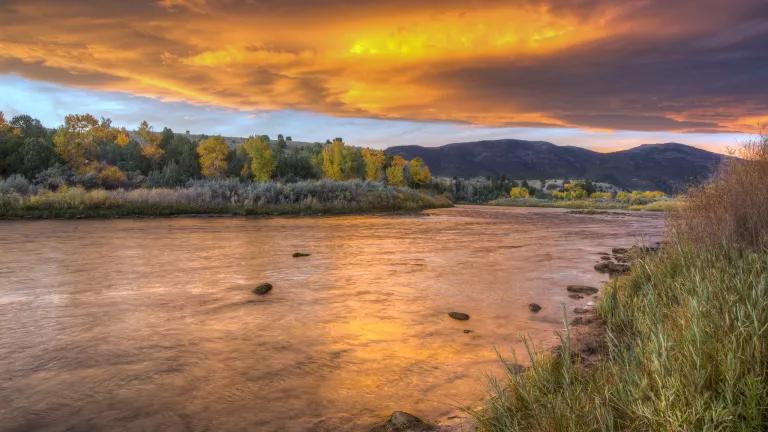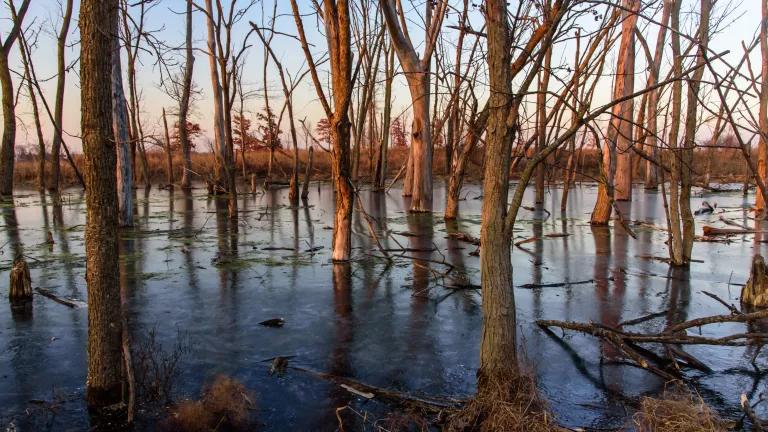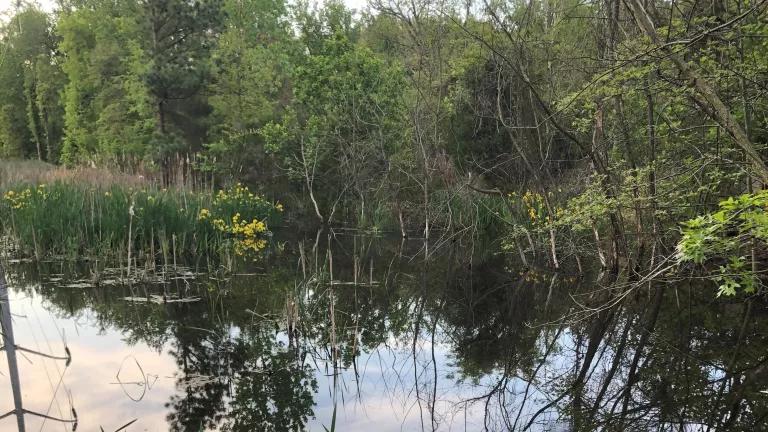
The State Water Resources Control Board today recommended potentially significant increases in Delta outflow, and reduced diversions throughout the Bay-Delta watershed, to protect water quality and our native fish and wildlife in this magnificent watershed and estuary. However, the Board’s recommendation that winter-spring Delta outflow should be 55% of unimpaired flow (unimpaired flow is what would flow naturally in the absence of dams and diversions) is significantly less than what the best available science shows is needed. The Board also recommends incorporating existing federal restrictions on the operations of the Central Valley Project and State Water Project, to ensure that fish and wildlife—and the thousands of fishing jobs that depend on them—are protected. These recommendations come just as the Trump Administration seeks to weaken those federal protections in the Delta.
As the Board recognizes, the Delta is in ecological crisis. The Board's approach of requiring a percentage of unimpaired flows to remain in the river and Delta is scientifically sound and has repeatedly been peer reviewed, as discussed in more detail below. But the details of the proposal matter, and will determine whether California sustains its native fish and wildlife for future generations. NRDC and our partners will closely review these documents over the coming weeks and months, and we look forward to the State Water Board releasing its environmental review of these proposals and alternatives later this year.
In 2009, the Legislature established state policy to reduce reliance on the Delta and invest in local and regional water supplies (Cal. Water Code § 85021). The Board estimates that its proposal would result in an estimated 17% reduction in diversions from the watershed (with is only a 5% reduction in total water supplies, since water diversions from the Bay-Delta account for less than one third of total water supplies used by all of us who divert from the Bay-Delta). However, California has a huge Untapped Potential to create millions of acre feet of new, sustainable water supplies by improving water use efficiency on farms and in cities, increasing water recycling, and capturing more stormwater in urban areas. These and other sustainable water supplies can help California protect the environment and sustain our economy for generations to come.
This State Water Board framework also has important implications for the California WaterFix, including the re-vote next week by the Board of Directors of the Metropolitan Water District of Southern California (MWD). MWD staff have sold the tunnels as a way to maintain or increase water diversions from the estuary, despite the fact that WaterFix would worsen Delta outflows compared to today and worsens conditions for native fish and wildlife. However, by proposing significant increases in Delta outflow and reduced diversions from the estuary, the State Water Board’s framework provides a clear signal that WaterFix will not maintain current levels of diversions, and MWD Board members should not be surprised when WaterFix yields significantly less water supply than MWD staff has claimed. Increased protections in the Delta will make local and regional water supplies even more cost-effective as compared to the tunnels, and today’s announcement from the State Water Board shows the wisdom of leaders in Southern California like Mayor Garcetti who are planning for a future with less water from the Delta.
Background Information on the Bay Delta Water Quality Control Plan
New Standards to Protect the Estuary Are Long Overdue
As the Board’s framework notes, the Bay-Delta is in ecological crisis, with salmon and other native fish species rapidly declining in abundance and heading towards extinction if the State doesn’t act. The State Water Board last substantively updated these standards in 1995, despite the statutory requirement to review these standards every 3 years. The current review of these standards began in 2008, and it is likely to conclude in 2019.
Increased Delta Outflows Are Scientifically Justified
For nearly a decade, the State Water Board and other state and federal agencies have been warning that current levels of water diversions are unsustainable, and that we must increase Delta outflow if we are going to restore and maintain a healthy San Francisco Bay and Bay-Delta estuary. For instance, in 2010 the Board completed its report on the flows needed to fully protect fisheries and Public Trust resources in the Bay-Delta, concluding that the best available science demonstrated that increased Delta outflow are necessary (it recommended that winter-spring Delta outflow would be 75% of unimpaired flow, with only 25% of unimpaired flow be diverted during these months). Similarly, in 2012, the National Research Council (part of the National Academies of Science) issued its report on Sustainable Water and Environmental Management in the California Bay-Delta that, concluded that:
Thus, it appears that if the goal is to sustain an ecosystem that resembles the one that appeared to be functional up to the 1986-93 drought, exports of all types will necessarily need to be limited in dry years, to some fraction of unimpaired flows that remains to be determined. Setting this level, as well as flow constraints for wetter years, is well beyond the charge of this committee and accordingly we suggest that this is best done by the SWRCB, which is charged with protecting both water rights holders and the public trust.
In 2017, the State Water Board released its peer reviewed report on the scientific basis for new water quality standards, which likewise concluded that the best available science demonstrated that significantly increased Delta outflow is needed to protect and restore the health of the estuary.
What Are Unimpaired Flows, and What Has the State Water Board Proposed?
The State Water Board has proposed that Delta outflows during the winter and spring be increased to a range of 45-65% of the unimpaired flow, with a starting point of 55% of unimpaired flow. This means that during these months, the amount of water flowing into the Delta and out of the Delta into Suisun Bay and San Francisco Bay are at least a certain percentage of the flow that would occur if there were no dams and diversions (a percentage of unimpaired flows). This approach is scientifically sound and has been repeatedly peer reviewed.
The State Water Board estimates that current January to June Delta outflow are approximately 44% of unimpaired flow in an average year, so the Board’s proposal would increase Delta outflows during most years (particularly drier years). However, the range of Delta ouflows is significantly lower than was recommended in the State Water Board’s 2010 report (75%).
This approach (using a percentage of unimpaired flows) can restore variability in the amount of river flows within years and between years, which is critically important to maintaining natural functions and sustaining native species, including salmon. Flows will be higher in wet years and lower in dry years, as people and the environment share the water. Requiring a higher percentage of unimpaired flows means that ecological functions and biologically-important flow thresholds are achieved more frequently. This approach also allows managers to have some flexibility to shape flows during the year to achieve specific ecological functions, while also allowing for natural variability in flows.
The Board’s general approach provides ecological benefits both upstream and downstream. It would increase flows in the Sacramento River and other rivers, which has been shown to increase salmon survival throughout the River. Downstream, these increased flows will improve water quality in the Delta and increase the survival and abundance of native species in the Delta, like longfin smelt or green sturgeon. Higher flows result in increased floodplain inundation, expanded low salinity habitat in the estuary, and help achieve other important ecological functions.



